Chapter 12 Long Questions
Q. 12.1. What do you understand by reflection of light? Draw a diagram to illustrate reflection at a plane surface.
Q. 12.2. Describe the following terms used in reflection:
(i) normal (ii) angle of incidence (iii) angle of reflection
Q.12.3. State laws of reflection. Describe how they can be verified graphically.
Q. 12.4. Define refraction of light. Describe the passage of light through parallel-sided transparent material.
Q.12.5. Define the following terms used in refraction:
(i) angle of incidence (ii) angle of refraction
Q.12.6. What is meant by refractive index of a material? How would you determine the refractive index of a rectangular glass slab?
Q.12.7. State the laws of refraction of light and show how they may be verified using rectangular glass slab and pins.
Q.12.8. What is meant by the term total internal reflection?
Q.12.9. State the conditions for total internal reflection.
Q.12.10. What is critical angle? Derive a relationship between the critical angle and the refractive index of a substance.
Q.12.11. What are optical fibers? Describe how total internal reflection is used in light propagating through optical fibers.
Q.12.12. Define the following terms applied to a lens:
(i) principal axis (ii) optical center (iii) focal length
Q.12.13. What is meant by the principal focus of a (a) convex lens (b) concave lens? Illustrate your answer with ray diagrams.
Q.12.14. Describe how light is refracted through convex lens.
Q.12.15. With the help of a ray diagram, how you can show the use of thin converging lens as a magnifying glass.
Q.12.16. A coin is placed at a focal point of a converging lens. Is an image formed? What is its nature?
Q.12.17. What are the differences between real and virtual images?
Q.12.18. How does a converging lens form a virtual image of a real object? How does a diverging lens can form a real image of a real object?
Q.12.19. Define power of a lens and its units.
Q.12.20. Describe the passage of light through a glass prism and measure the angle of deviation.
Q.12.21. Define the terms resolving power and magnifying power.
Q.12.22. Draw the ray diagrams of (i) simple microscope (ii) compound microscope (iii) refracting telescope
Q.12.23. Mention the magnifying powers of the following optical instruments:
(i) simple microscope (ii) compound microscope (iii) refracting telescope
Q.12.24. Draw ray diagrams to show the formation of images in the normal human eye.
Q.12.25. What is meant by the terms nearsightedness and farsightedness? How can these defects be corrected?
CONCEPTUAL QUESTIONS
Q.12.2 In your own words, explain why light waves are refracted at a boundary between two materials.
Q.12.4 Why or why not concave mirrors are suitable for makeup?
Q.12.5. Why is the driver’s side mirror in many cars convex rather than plane or concave?
Q.12.7. How does the thickness of a lens affect its focal length?
Q.12.8. Under what conditions will a converging lens form a virtual image?
Q.12.9. Under what conditions will a converging lens form a real image that is the same size as the object?
Q.12.10. Why do we use refracting telescope with large objective lens of large focal length?
Q. 12.1. What do you understand by reflection of light? Draw a diagram to illustrate reflection at a plane surface.
Answer: When light ray is completely returns- back into some medium after felling
from a polished surface is called “reflection of light”
Draw:

Q. 12.2. Describe the following terms used in reflection:
(i) normal (ii) angle of incidence (iii) angle of reflection
Answer:
Normal:
‘The perpendicular drawn on the reflecting plane, at point of incidence of ray of light as called “normal”.
Angle of Incidence
The angle between incident ray and normal is called angle of incidence.
Angle of reflection
The angle between reflected ray and normal is called angle of reflection.
Q.12.3. State laws of reflection. Describe how they can be verified graphically.
Answer: There are two laws of reflection of light.
a. The incident ray the normal and the reflected ray at the point of incidence all lie in the same plane.
b. The angle of incidence is equal to the angle of reflection.
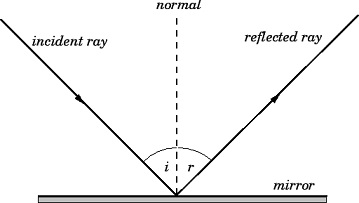
Q. 12.4. Define refraction of light. Describe the passage of light through parallel-sided transparent material.
Answer: In physics, refraction is the change in direction of a wave passing from one medium to another or from a gradual change in the medium. Refraction of light is the most commonly observed phenomenon, but other waves such as sound waves and water waves also experience refraction.
If a ray of light hits the surface of a sheet of glass, some light will be reflected by the surface of the glass. However, much of the light will pass through the glass, because glass is transparent. This bending of a ray of light when it passes from one substance into another substance is called refraction.
Q.12.5. Define the following terms used in refraction:
(i) angle of incidence (ii) angle of refraction
Answer:
(i) angle of incidence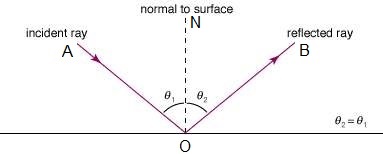
The angle shown in the figure between incident ray (AO) and the normal (ON) is called angle of incident which is denoted by <AON = < θ1
(ii) angle of refraction
The angle between the reflected ray (OB) and the normal (ON) is called angle of reflection and is denoted by <ONB = < θ2
Q.12.6. What is meant by refractive index of a material? How would you determine the refractive index of a rectangular glass slab?
Answer: The ratio of sine of angle of incidence to the angle of refraction is called refractive index the refractive index of a glass slab is determined experimentally by using formula.
Refractive index = sin θ1 / sin θ2
Q.12.7. State the laws of refraction of light and show how they may be verified using rectangular glass slab and pins.
Answer:
1st Law .
It states that incident ray, normal and refracted ray lie in same plane.
2nd Law
It states that ratio of sine of angle of incidence to the sine of angle of refraction is constant (Snell’s law) .
Q.12.8. What is meant by the term total internal reflection?
Answer: When a light ray is incident upon the separating surface, coming from denser medium for which angle of reflection in rare medium is greater than 90° , then its is called total internal reflection.
Q.12.9. State the conditions for total internal reflection.
Answer: The following are conditions of total internal reflection.
(i) The incident ray should come from denser medium at angle of incidence greater then critical angle.
(ii) The totally reflected ray is received in the same denser medium.
Q.12.10. What is critical angle? Derive a relationship between the critical angle and the refractive index of a substance.
Answer: Critical angle
The critical angle is defined as the angle of incidence that provides an angle of refraction of 90-degrees. Make particular note that the critical angle is an angle of incidence value. For the water-air boundary, the critical angle is 48.6-degrees.
Relation Between Critical Angle And Refractive Index. In Optics, The angle of incidence to which the angle of refraction is 900 is called critical angle. The ratio of velocities of a light ray in the air to the given medium is refractive index.
Q.12.11. What are optical fibers? Describe how total internal reflection is used in light propagating through optical fibers.
Answer: Optical fibers: It is a hair size thread made up of glass for plastic through which light can be traveled.
a. The inner part of fiber optic is called core that carries light.
b. The outer part is concentric shell caused cladding.
Total internal reflection used in fiber optics
When light traveling in an optically dense medium hits a boundary at a steep angle (larger than the critical angle for the boundary), the light is completely reflected. This is called total internal reflection. This effect is used in optical fibers to confine light in the core.
Q.12.12. Define the following terms applied to a lens:
(i) principal axis (ii) optical center (iii) focal length
Answer:
(i) Principal axis
The line passing through pole and focal point is called principle axis of lone.
(ii) Optical center
The central symmetric point of a lens is called optical center.
(iii) Focal length
The distance between focal point and optical center of lens is called its focal length.
Q.12.13. What is meant by the principal focus of a (a) convex lens (b) concave lens? Illustrate your answer with ray diagrams.
Answer:
(a) Convex lens: The principal focus of a convex lens is defined as the point on which the principal axis of the light is parallel to the principal axis that converges after the refraction from the lens.
b) Concave lens: The principal focus of concave lens is when the light rays get diverged and appear to form a single point.
Ray Diagrams:

Q.12.14. Describe how light is refracted through convex lens.
Answer: A convex lens is a system of two prisms placed base to base as shown in Convex lens bends the light towards the principal axis that is towards thickest pan of the lens after refraction. Rays of light that pass through the lens are brought closer together (they converge). A convex lens is a converging lens. When parallel rays of light pass through a convex lens the refracted rays converge at one point called the principal focus.
Q.12.15. With the help of a ray diagram, how you can show the use of thin converging lens as a magnifying glass.
Answer: A magnifying glass is a convex lens used to make an object appear much larger than it actually is. This works when the object is placed at a distance less than the focal length from the lens. The image is:
- upright (the right way up)
- magnified (larger than the object)
- virtual (cannot be produced on a screen)
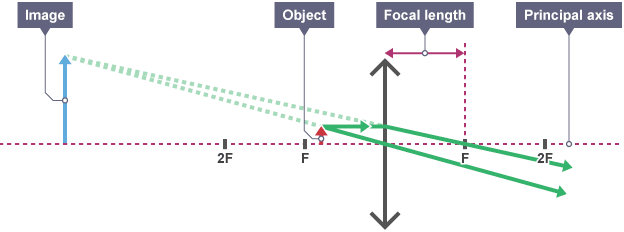
Ray diagram for an object placed less than one focal length from a convex lens
Only the person using the magnifying glass can see the image. The image cannot be projected onto a screen because it is a virtual image.
Q.12.16 A coin is placed at a focal point of a converging lens. Is an image formed? What is its nature?
Answer: If a coin (object) is placed at a focal point of a converging lens its image is not formed because rays become parallel after passing through the lens.
Q.12.17. What are the differences between real and virtual images?
Answer: Real image is that image which can be formed on a screen but the virtual image can’t’formed on a screen.
- Real images are formed when light rays after reflection or refraction converge at a point before a mirror or lens. While virtual images are formed when the light rays diverge after reflection or refraction.
- Real images appear on the screen as against virtual images never appear on the screen.
- Converging types of lenses are used to produce a real image. Whereas diverging lens is used for the formation of virtual images.
- Real images are inverted in nature. While virtual images appear erect.
- Generally, concave mirrors or convex lenses form real images. Plane mirror, convex mirror, and concave lens are regarded as the virtual image forming surfaces.
- The front region of the mirror forms real images. Whereas virtual images are assumed to be formed behind the mirror.
- Real images are formed due to the actual interaction of real rays. However, virtual images are formed when light rays imaginary interact with each other.
- In the case of the real image, the light rays diverge from the same side of the mirror after converging and forming the real image. While in the case of the virtual image, the light rays assumed to diverge from a point somewhere behind the mirror.
Q.12.18. How does a converging lens form a virtual image of a real object? How does a diverging lens can form a real image of a real object?
Answer: In case of converging lens: A virtual image is formed of a real object when it is placed between the focal point and optical center of the lens.
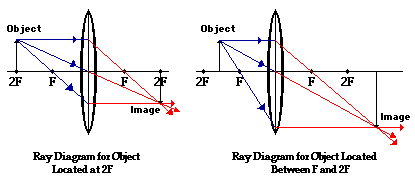
As shown above, real images are produced when the object is located a distance greater than one focal length from the lens. A virtual image is formed if the object is located less than one focal length from the converging lens. To see why this is so, a ray diagram can be used.
Q.12.19. Define power of a lens and its units.
Answer: Power of a lens is defined as the inverse of focal length (in meters) of the lens. It is a measure of the amount of deviation of light ray produced by a lens, more the power, more is the deviation. Unit of power is Dioptre ().
Convex lens has positive power and concave lens has negative power. Power of a plane glass plate is . Power of combinations of lenses kept close to each other is equal to the sum of individual powers of each lens.
Q.12.20. Describe the passage of light through a glass prism and measure the angle of deviation.
Answer: The incident ray bends towards the normal when it enters the prism and while leaving the prism it bends away from the normal. With the increase in the angle of incidence, the angle of deviation decreases. After attaining the minimum value, it increases with an increase in the angle of incidence.
Precautions
- For drawing the boundary of the prism, a sharp pencil should be used.
- Soft board and pointed pins should be used.
- The distance between the pins should be 5cm or more.
- The pins should be fixed vertically and should be encircled when they are removed from the board.
- The angle of incidence should be between 30° and 60°.
- The arrows drawn for incident ray, reflected ray and emergent ray should be proper.
- For viewing the col-linearity of all the four pins and images, the head should be slightly titled on either side. While doing this it can appear as all are moving together.
Q.12.21. Define the terms resolving power and magnifying power.
Answer: Magnification
Magnification is the ability to make small objects seem larger, such as making a microscopic organism visible. Magnification is the process of enlarging something only in appearance, not in physical size. This enlargement is quantified by a calculated number also called “magnification. ”
Resolution: Resolution is the ability to distinguish two objects from each other.
Q.12.22. Draw the ray diagrams of (i) simple microscope (ii) compound microscope (iii) refracting telescope
Answer: (i) Simple Microscope
A simple microscope is used to obtain small magnifications. It is usually used for study of microscopic algae, fungi and biological specimen.
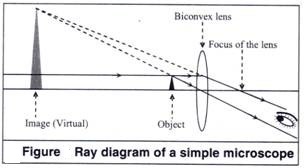
(ii) Compound Microscope
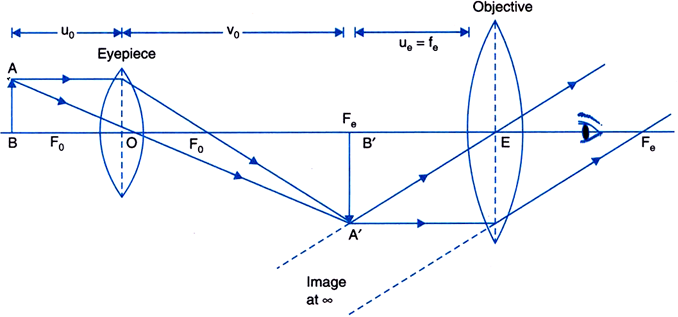
(iii) Refracting Telescope
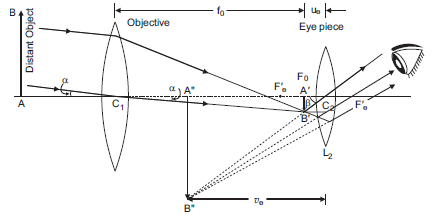
Q.12.23. Mention the magnifying powers of the following optical instruments:
(i) simple microscope (ii) compound microscope (iii) refracting telescope
Answer: (i) Simple Microscope
The magnifying power of a simple microscope is given by:
M = 1 + d / ƒ
where ƒ is the focal length of lens and d is near point of eye.
(ii) Compound Microscope
The magnification of the compound microscope is given by:
![]()
where L is the length of a compound microscope which is equal to the distance between objective and eye piece, d is distance of final image from eye, and are the focal lengths of objective and eye piece respectively.
(iii) Refracting Telescope
Magnifying power of a telescope is defined as the ratio of the angle subtended at the eye by the image formed at the least distance of distinct vision to the angle subtended at the eye by the object lying in infinity.
Answer: A ray-diagram can be used to show how light passes from a point on a real object (located somewhere in space outside the body) to the corresponding position on the image of the object on the retina at the back of the eye. The following example is explained below:

Q.12.25. What is meant by the terms nearsightedness and farsightedness? How can these defects be corrected?
Answer: Nearsightedness: Nearsightedness, or myopia, is the inability to see distant objects and is corrected with a diverging lens to reduce power.
Farsightedness: Farsightedness, or hyperopia, is the inability to see close objects and is corrected with a converging lens to increase power.
Both nearsightedness and farsightedness can be treated with corrective eyeglasses and contact lenses. The lenses work by changing the way light rays bend into the eyes.
Q.12.1 A man raises his left hand in a plane mirror, the image facing ‘him is raising his right hand. Explain why.
Answer: Laterally laterally inverted image is formed in case of a plane mirror. So if the object (person) raises his left hand then its image will raise his right hand and vice versa.
Q.12.2 In your own words, explain why light waves are refracted at a boundary between two materials.
Answer: It is one or the basic properties of light waves. Light waves refract at the boundary of two media having different values of refractive index.
Q.12.3 Explain why a fish under water appears to be at a different depth below the surface than it actually is. Does it appear deeper or shallower?
Answer: When we see fish under water the light rays travelling from water to air, coming out rays bend from their straight path due to effect of refraction it seems at less depth than it actually is. So it appear shallower as showing in figure.

Q.12.4 Why or why not concave mirrors are suitable for makeup?
Answer: When face is placed between the concave mirror and its focus, it produces a magnified image. This enlarged image of face is helpful in makeup as even pores of skin are clearly visible.
Q.12.5. Why is the driver’s side mirror in many cars convex rather than plane or concave?
Answer: Convex mirror is used as side mirror in cars because it produces image that are smaller than the size of the objects. This increases the view for the driver.
Q.12.6. When an optician’s testing room is small, he uses a mirror to help him test the eyesight of his patients. Explain why.
Answer: When optician uses a mirror to test the eye sight of his parents. He places a mirror in the half distance of the required because he knows the image is formed behind the mirror at the same as the object is placed in front of the mirror.
Q.12.7. How does the thickness of a lens affect its focal length?
Answer: A lens with more “bending power” has a shorter focal length, because it alters the path of the light rays more effectively than a weaker lens. But for thicker lenses, how thick they are does make a difference, and in general, results in a shorter focal length.
Q.12.8. Under what conditions will a converging lens form a virtual image?
Answer: A virtual image is formed if the object is located less than one focal length from the converging lens. To see why this is so, a ray diagram can be used.
A ray diagram for the case in which the object is located in front of the focal point is shown in the diagram at the right.
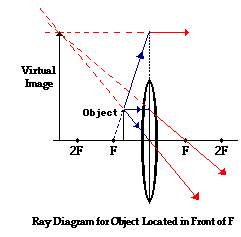
Q.12.9. Under what conditions will a converging lens form a real image that is the same size as the object?
Answer: When an object is place at 2F then its image formed at 2F on the other side of the lens having same size. It is real, inverted and same size image as object.
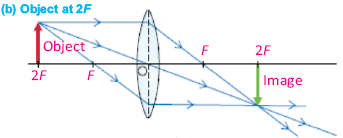
Q.12.10. Why do we use refracting telescope with large objective lens of large focal length?
Answer: As we know that magnification of refracting telescope is given as:

It is clear objective lens of larger focal length gives high magnification.